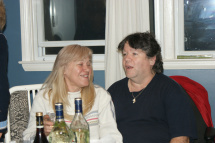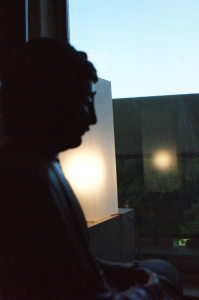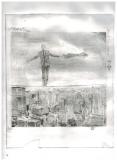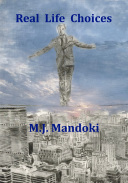M.J. Mandoki's Blog, page 13
July 21, 2015
Gratitude
I would like to say a few words about my collaborators, now that my new book, Real Life Choices, is up on amazon.com.
Two people gave me tremendous amount of help in creating my covers for the book. First, my nephew, Anthony Santa, who is just twenty years old, did the illustrations for both the front and the back covers. He is a tremendous talent. I can’t believe how good he is with a pencil and paper in hand. Second, my coworker, Ray Barnicoat, is incredible when it comes to cover design. He is a semi-retired man in his sixties who is better than most young people in terms of his computer skills. His hands are magical. He was capable of taking my nephew’s black and white drawings and add amazing colours to them to make them come alive.
When the proof copy was in my hand, they both had wonderful reactions to it. Ray was all smiles. I could feel the pride and joy, as he watched his hard work on the covers. Anthony wanted a hug from his aunt right away. I was so proud of my team! They are wonderful! I can’t thank them enough!
As a writer, I can feel really blessed to have some amazing people around me. They are talented, hard-working and full of joy and pride. Thank you, guys! Truly!
Here are the pictures for the front cover. The black and white picture is the original drawing and the colour picture is the final product.
If anybody needs to borrow my talented team, please, let me know.
M. J. Mandoki


July 12, 2015
Real Life Choices
My second book will be out within a week! It will be available on amazon.
Here is the official summary of the book:
In the stories that make up Real Life Choices, the characters find themselves in unusual circumstances where they face psychological and/or moral challenges. Depending on the story, these unusual circumstances include criminal wrongdoings, sexist attitude, seemingly unreal video game characters, ghost sightings, afterlife figures and bizarre environments. Both characters and readers are left to make choices about the interpretations and conclusions of these events. The stories move from the simple to the absolutely bizarre to force the characters, different in every story, to make choices in these more and more difficult situations, while they are almost always left to their own devices. The stories can be classified as psychological/supernatural and philosophical fictions.
The first story is very short. After an explosion in the building, a strange meeting takes place in an office with originally anticipated guests from the business community–or, so it appears. In the second story, a teenager runs away and is saved by an “angel”. The third tale focuses on a mystery surrounding an emergency call a truck driver receives through his CB radio. It is followed by, “My Chosen Path”, which is about a female security guard who finds drug dealers at an abandoned warehouse on the property she guards at night. As things get complicated, she finds herself running for her life. In the story, entitled, “On the Road of Destiny,” a biker stops to offer a ride to a fellow motorcyclist left on the side of the road with a motorcycle that would not start. When he declines the help, the biker suddenly takes off, refusing to even stop at the next repair garage to let the mechanics know about the stranded motorcyclist. The next fictional account, called “Magical World,” follows a video-gamer, bored of everyday life, who finds himself in a battle with his game characters one night on the way home from work. The bizarre event spills over to the next day. The gamer struggles to find explanation for the mysterious events, taking place around him. In the long tale of “The Hermit’s Journal,” the protagonist is a psychology professor who isolates himself on a mountain at winter time, living without any human contact, in order to write a book. Even though he is aware of the fact that only one woman lives on the mountain across, he keeps seeing two women. The mystery behind the two women captures his attention while he is also dealing with the psychological effect of isolation on the day-to-day basis. In the final story, called “Lucidity”, the protagonist finds herself walking on Grey Street with a pressing need to complete three chores. With ever increasing bizarre events taking place, she finds the chores difficult to complete, until she figures out the cause of the bizarre happenings. Aware of the cause, she needs to make a choice about how to proceed given this knowledge.
All stories represent real life situations in a sense that it is possible for virtually anyone to be faced with such challenges and difficulties in real life.
M. J. Mandoki


July 5, 2015
Understanding Types of Theism

Theism?!
I have read an article, entitled, “Neopaganism, Feminism, and the New Polytheism,” written by Norman L. Geisler, that infuriated me. The amount of misunderstanding that people have about the different kinds of theism and related concepts is maddening. Therefore, I decided to clear up the confusion and point out the problem with his evaluation of polytheism. This is not just important for philosophically oriented people, but for writers, as well. It is not proper to look up a name of a god in another religion, plug it into a creative work and pretend that it is a replacement for the Christian or other God.
The following are the basic terms to remember. Monotheism is a belief in one god. It is the denial that there is more than one. In western religions, this god is transcendent; meaning that, God stands outside and above his creation. God is usually referred to as male in gender. God created the world, but stands over and above it. Hence, there is a clear distinction between God and his creation. This leads to dualism, a distinction between spiritual/mental and physical realms. Also, God may or may not have a relationship with the created world. If he is thought to have a relationship, he does this usually through revelations and miracles. On the other hand, he may be perceived as having no close ties with the world. For example, the deists believe that God created the world, but does not intervene, at all.
As opposed to the monotheism, polytheism recognizes the multiplicity of gods. They exist in the world either as actual beings or as symbolic representations or personifications of certain powers. Often times, these gods coexist and have similar status in their world. In henotheism, one god is often elevated above all other gods. This god is thought to be more important than the others. In Hinduism, Krishna, Shiva or Yama often achieves this elevated status. In Greek mythology, Zeus is often thought to take this position. In polytheism and henotheism, there are both male gods and female goddesses. In ancient times, people performed rituals, offered sacrifices and evoked the gods for help or for favors. In modern times, the offerings of sacrifices are no longer done. Despite the multiplicity of gods/goddesses in polytheism and henotheism, there is a belief in an underlying unity of reality. Reality is one. Basically, the system denies dualism because dualism splits reality into spiritual/mental and physical realms. Instead, it embraces the idea of oneness where the separation into multiplicity exists on the surface only, mostly argued as a result of perception and cognition. For the polytheists and henotheists, the world is both imminent and transcendent in nature. Basically, the oneness of reality does not allow the Ultimate—The One, The Ground of Being, God, Brahman, Sunyata—to transcend the world. If it is truly one, it is everywhere and nowhere in specific. Of course, with the passing of time, the interpretation of certain systems may change. For example, Ramanuja and Madhva in the Advaita Vedanta of Hinduism developed a qualified and non-qualified dualism of Brahman. Also, Baruch Spinoza made pantheism popular in the 17th century where God is imminent, identified with nature. At the end, though, the major difference between monotheism and polytheism is the while the monotheist believes that there is one God; the polytheist believes that God (the Ultimate) is one.
The reason Geisler’s article infuriated me is because he does not make proper distinctions amongst the above mentioned concepts. For example, he claims on page six, that monotheism is superior to polytheism because polytheism is in denial of ultimate unity and because it is in denial of creationism. Firstly, polytheism is not in denial of unity. In fact, monotheism is more in denial of unity than polytheism is. Monotheism leads to dualism while polytheism embraces monism. This means that the monotheist is forced to live in the duality of spiritual/mental and physical realms while the polytheist, denying this duality, is free to exist in the unity of oneness of reality. Hence, polytheism recognizes the unity of all more than monotheism. Secondly, polytheism does not recognize creationism because there is not a transcendent God to create the world. In Hinduism, the world is a facet or expression of Brahman. Since Brahman is one, the world is also Brahman. It is more appropriate to think that the world came to be much like a spider’s creation of a web where both the spider and the web are ultimately one. Moreover, Geisler complains that a pagan fails to submit to the Ultimate God. But, she actually does! A pagan recognizes the oneness of reality and admits to the fact that reality is both imminent and transcendent in nature. In fact, most pagans are environmentalists because they are aware of the importance of protection of nature, as nature is part of the harmonious oneness of reality.
It would be great if people understood and used the required concepts before critiquing a system of belief. It is important to get the different theisms and related ideas right first. This is a great lesson for writers, as well. It is inappropriate to pick, for example, Sarasvati; the Hindu goddess of inspiration of music, poetry, drama and science; and, pretend that she fills a role similar to the Christian God. Although, musicians still pray to her before a performance, she is not like a Christian God. She does not create a world and watches it from heaven! She represents a specific power of the oneness of reality that the Hindus refer to as Brahman. Therefore, it is important for all writers to research and to be careful when using theistic concepts. I hope that my venting helped to clarify some ideas. Happy writing!
M. J. Mandoki


June 30, 2015
Gay Marriage?
 Last week, the U.S. Supreme Court decided to acknowledge gay marriage. Since then, I have heard several unpleasant comments from those who do not like the idea. The interesting thing is that these comments were made in Canada where the Canadian Supreme Court has voted in favour of gay marriage over a decade ago.
Last week, the U.S. Supreme Court decided to acknowledge gay marriage. Since then, I have heard several unpleasant comments from those who do not like the idea. The interesting thing is that these comments were made in Canada where the Canadian Supreme Court has voted in favour of gay marriage over a decade ago.
What points are the naysayers making? Initially, I always thought that the problem had to do with intolerance. The traditionalists believe in a morality according to which people should only have sex with the opposite gender and they want to impose their sense of morality on others. It seemed that no philosophical arguments could sway them. My greatest argument was that two consenting adults could do with each other whatever they chose to do. Since they do not harm anyone by loving each other, why do the traditionalists care so much what gender they are?
As it turns out, the matter is not that simple. The latest comments I have heard made me think that the traditionalists are not necessarily intolerant; rather, they are scared. It seems that showing understanding and tolerance means that they are afraid of having to agree with this lifestyle. The fear is that if they agree with this lifestyle then they lose their own belief in a traditional marriage. The structure of the philosophical argument seems to be that, “If I agree that you may be right then I am automatically wrong and, I have to believe what you believe”. Of course, the traditionalists seem to be horrified that this argument makes them open to entertaining the idea of having to contemplate the possibility, in their own lives, to marry someone of the same gender. As twisted as it seems, supporting gay marriage leads to the fear of becoming gay.
I have to say that I am surprised of the amount of fear born out of a misunderstanding of the structure of the basic argument. The argument in support of gay marriage is an argument for human rights. It is about a freedom to choose. It is an argument in support of the belief that people have the right to choose whom they marry. Agreeing with this right does not take away from the value of the traditionalists’ position. If traditionalists believe that they should marry a member of the opposite gender only, they are free to fulfill this obligation in their own lives. The support for gay marriage does not take away their own freedom and does not impose a moral obligation on them to participate in gay marriage. The gain is freedom for others and not the loss of morality for some. In fact, there is no loss, at all.
The best example I can offer is from fiction writing. Traditionalist fiction writers can choose to create stories where there are no gay couples in any of their tales. All they have to do is to tolerate those writers who embrace the support for gay marriage and choose to incorporate gay characters in their tales. In fact, I have to say that, just like in my case, one does not have to be gay to include all types of characters in a story. Despite the fact that I am not gay, I am planning to include a lesbian woman in one of my upcoming books.
The world does not lose by everyone gaining equal rights. So, relax everyone! The world is big enough to include everyone’s love for each other!

SONY DSC
M. J. Mandoki


June 21, 2015
The Art of Revenge (Do not do this in real life!)
Revenge is a powerful motivator. A person is motivated to inflict harm on another person at whose hands he suffered a great injury or wrong. A revengeful person is out to destroy; there is no mercy. Since revenge seems to be such a human instinct, it has probably been part of human history right from the beginning. As most people, I believe that it is immoral and/or unethical to take revenge. However, as a writer, I would like to comment on revenge plots since they seem to be such an integral part of great many stories.
Firstly, it is wise to note that revenge is born out of a negative emotion. Basically, revenge is the result of anger. This means that people who seek revenge act on the basis of anger. This is the reason that a revengeful act is rarely thought out. In its raw form, revenge is a direct hit on the target. Its physical expression usually consists of a person being punched, struck, beaten, bludgeoned, cut or shot. The physical expression ranges from nasty to deadly, depending on the person and/or the amount of anger present. Many readers find it difficult to read about an act of revenge. They may find it repulsive, offensive or even monstrous. Some writers shy away from creating acts of revenge in their creative pieces for this very reason. It is a mistake, though. Since revenge is an ever-present powerful negative emotion, it is natural to find constant examples of it, even in its raw form. Thus, writers should not shy away from an accurate portrayal of an act of revenge that is born without thinking through the situation.
In some cases, revenge may take a more sophisticated form. In a highly civilized and politically correct society, the more educated population is forced to turn to well-designed revenge plots. For example, if a manager is angry at an employee, he cannot just punch the employee in the face. Of course, in such a society, citizens would like to believe that, since revenge is wrong, it can be eradicated by rationally explaining to people that it is immoral and unethical to engage in acts of revenge. Unfortunately, this approach does not work. Because revenge is not a rational thought, but, rather, a human emotion, many people feel the need to react to the injury they suffer by wanting to inflict harm. They may bottle up the anger for a while, but, eventually, the bottled-up anger causes the person to blow just like an overloaded fuse does in fuse box. Instead of a sudden, irrational reaction, though, people, in a highly civilized and politically correct society, come up with sophisticated ways of taking revenge. For example, the angry manager, instead of punching an employee, may single out the employee, magnifying the person’s small mistakes in an attempt to embarrass, shame, anger or cause discomfort to the person. Of course, this technique may not work at all times. If the intended target laughs it off or even makes a bet on being targeted, the revengeful act becomes insignificant and ineffective. In fact, it may backfire, further angering the manager. It can also damage his reputation. After all, others do notice around him what he is up to and develop a very poor opinion about him. In a creative piece, capturing this sophisticated form of revenge takes hard work because the writer has to capture both the person’s anger and his spur-of-the-moment plot for an act of revenge. Still, it is worth pursuing this type of revengeful act in a creative work, since most modern-day readers do live in a highly civilized and politically correct society where a punch in the nose is not always available as a solution to anger.
In rare cases, revenge may take a very highly sophisticated form. This form includes a calming down period where a person can rationally think through the plan for revenge. In this scenario, the person is still holding on to the emotion of anger and, hence, the desire for revenge, but she is willing to regain her calm and collected demeanor first in order to create a rationally thought-out plan before executing her revenge. This individual is cunning, artful and calculative with an excellently timed, detailed plan worked out in her mind. At its highest scale, the victim of revenge is unaware that the pain being inflicted upon her is the result of an act of revenge until the plan is completed. In some cases, it is even possible that, if she gains knowledge of the plot, she is unable to prove that she has fallen victim to a revengeful plot of an angry person. In a creative piece, designing this type of sophisticated revenge plot takes time and effort. The writer has to become this cunning, artful and devious character and has to become capable of thinking outside the proverbial box to come up with an original idea for a sophisticated plot. It is worth making the effort, though, because a sophisticated revenge-plot is always delightful to read.
As a final note, I have to point out that it is possible not to inflict pain on a person who caused an injury. It takes a type of psychological effort, though, that few people would make. A person needs to convince herself to let go of the emotional pain suffered by the injury or wrong. A strong individual is capable of letting go because she knows that, despite the injury inflicted, things will work out. Therefore, it makes no sense to put energy and effort into an act of revenge. The act of letting go frees up the person’s time to concentrate on achieving success. However, it takes a very positive and optimistic person in life to adopt this viewpoint because the person has to believe in herself and in her success. Unfortunately, it is rare to find such an individual in society. Naturally, for a creative writer, it is fun to portray this type of person in a creative piece on occasions. It is important for the writer to remind herself, though, that this type of person is the exception and not the rule in the world of revenge.
In the fascinating world of revenge, it is wonderful to accurately demonstrate an angry person who is ready to act. May they always be part of the world of creative imagination, but, hopefully, never in real life! Do not attempt an act of revenge in real life because it is wrong and karma is a b#$%*. Happy writing!
M. J. Mandoki


The Art of Revenge
Revenge is a powerful motivator. A person is motivated to inflict harm on another person at whose hands he suffered a great injury or wrong. A revengeful person is out to destroy; there is no mercy. Since revenge seems to be such a human instinct, it has probably been part of human history right from the beginning. As most people, I believe that it is immoral and/or unethical to take revenge. However, as a writer, I would like to comment on revenge plots since they seem to be such an integral part of great many stories.
Firstly, it is wise to note that revenge is born out of a negative emotion. Basically, revenge is the result of anger. This means that people who seek revenge act on the basis of anger. This is the reason that a revengeful act is rarely thought out. In its raw form, revenge is a direct hit on the target. Its physical expression usually consists of a person being punched, struck, beaten, bludgeoned, cut or shot. The physical expression ranges from nasty to deadly, depending on the person and/or the amount of anger present. Many readers find it difficult to read about an act of revenge. They may find it repulsive, offensive or even monstrous. Some writers shy away from creating acts of revenge in their creative pieces for this very reason. It is a mistake, though. Since revenge is an ever-present powerful negative emotion, it is natural to find constant examples of it, even in its raw form. Thus, writers should not shy away from an accurate portrayal of an act of revenge that is born without thinking through the situation.
In some cases, revenge may take a more sophisticated form. In a highly civilized and politically correct society, the more educated population is forced to turn to well-designed revenge plots. For example, if a manager is angry at an employee, he cannot just punch the employee in the face. Of course, in such a society, citizens would like to believe that, since revenge is wrong, it can be eradicated by rationally explaining to people that it is immoral and unethical to engage in acts of revenge. Unfortunately, this approach does not work. Because revenge is not a rational thought, but, rather, a human emotion, many people feel the need to react to the injury they suffer by wanting to inflict harm. They may bottle up the anger for a while, but, eventually, the bottled-up anger causes the person to blow just like an overloaded fuse does in fuse box. Instead of a sudden, irrational reaction, though, people, in a highly civilized and politically correct society, come up with sophisticated ways of taking revenge. For example, the angry manager, instead of punching an employee, may single out the employee, magnifying the person’s small mistakes in an attempt to embarrass, shame, anger or cause discomfort to the person. Of course, this technique may not work at all times. If the intended target laughs it off or even makes a bet on being targeted, the revengeful act becomes insignificant and ineffective. In fact, it may backfire, further angering the manager. It can also damage his reputation. After all, others do notice around him what he is up to and develop a very poor opinion about him. In creative piece, capturing this sophisticated form of revenge takes hard work because the writer has to capture both the person’s anger and his spur-of-the-moment plot for an act of revenge. Still, it is worth pursuing this type of revengeful act in a creative work, since most modern-day readers do live in a highly civilized and politically correct society where a punch in the nose is not always available as a solution to anger.
In rare cases, revenge may take a very highly sophisticated form. This form includes a calming down period where a person can rationally think through the plan for revenge. In this scenario, the person is still holding on to the emotion of anger and, hence, the desire for revenge, but she is willing to regain her ability to create her calm and collected demeanor to create a rationally thought-out plan before executing her revenge. This individual is cunning, artful and calculative with an excellently timed, detailed plan worked out in her mind. At its highest scale, the victim of revenge is unaware that the pain being inflicted upon her is the result of an act of revenge until the plan is completed. In some cases, it is even possible that, if she gains knowledge of the plot, she is unable to prove that she has fallen victim to a revengeful plot of an angry person. In a creative piece, designing this type of sophisticated revenge plot takes time and effort. The writer has to become this cunning, artful and devious character and become capable of thinking outside the proverbial box to come up with an original idea for a sophisticated plot. It is worth making the effort, though, because a sophisticated revenge-plot is always delightful to read.
As a final note, I have to point out that it is possible not to inflict pain on a person who caused an injury. It takes a type of psychological effort, though, that few people would make. A person needs to convince herself to let go of the emotional pain suffered by the injury or wrong. A strong individual is capable of letting go because she knows that, despite the injury inflicted, things will work out. Therefore, it makes no sense to put energy and effort into an act of revenge. The act of letting go frees up the person’s time to concentrate on achieving success. However, it takes a very positive and optimistic person in life to adopt this viewpoint because the person has to believe in herself and in her success. Unfortunately, it is rare to find such an individual in society. Naturally, for a creative writer, it is fun to portray this type of person in a creative piece on occasions. It is important for the writer to remind herself, though, that this type of person is the exception and not the rule in the world of revenge.
In the fascinating world of revenge, it is wonderful to accurately demonstrate an angry person ready to act. May they always be part of the world of creative imagination! Happy writing!
M. J. Mandoki


June 14, 2015
The Weather Talk
Canadians love to talk about the weather. It the official small talk standing in line at the cash register, in the elevator or in the office. It is such a habit that most people cannot help it, but do it automatically without thinking. So, what can one learn listening to all this weather talk?
What is the weather like?
Lately, I’ve been paying close attention to the types of comments made. I realized that it is possible to learn about people based on their remarks. For example, an elderly woman complains to me endlessly every time I meet her. If the sun is out, it is too hot. It is possible to get sunburn and get sick. If it is cloudy, the rain may arrive any time and she may get soaked. If it is windy, her expensive hairdo may get ruined. Whatever the weather is, she always has some negative comments. Nothing can make her happy. She is the official complainer of the universe, ready to whine at any time. Another middle aged man, I know, can only be happy if the weather is perfect. In his case, it means that the weather has to be cool, slightly cloudy with not humidity. He is unhappy about 90% of the time and smiling in about 10% of the time. He is the official perfectionist in this life. One of my acquaintances, a middle aged man, is always happy. If it is sunny, he is happy about the sunshine. If it rains, he is happy that the flowers can drink and become beautiful. If it is cloudy, he finds the puffy clouds spectacular enough to take pictures of them. In short, he thinks that any weather is great. He is the official happy man. In summary, I determined that the types of comments people make about the weather say a lot about them.
Why is this important? It can influence a person’s life. For example, a smart interviewer can use this type of small talk to learn about a candidate’s personality at a job interview. The interviewer can begin by stating a fact about the weather. For instance, she can state, “It is raining outside,” and then wait for a response from the candidate. What is the person’s response? Depending on the person, it can vary. It is absolutely terrible! It is nasty outside! I guess, the air is fresh outside! It is good for the farmer’s land! I love the rain! The point is that the interviewer can learn a lot about the person before the interview even begins.
A person’s attitude can also influence his or her creative writing. The official complainer will probably make the weather a nuisance that a character constantly has to deal with. The perfectionist will probably choose perfect weather when a character is happy and imperfect weather when he is challenged or sad. This means that the lovers realize that they are in love with rain pouring down on a summer night. I guess that the perfectionist most probably loves clichés. The happy writer will probably choose a variety of weather for the character to deal with or ignore the weather question altogether. After all, he is always upbeat, no matter what the weather is. Of course, an experienced and fully aware writer may take the created character’s personality into consideration. If one is less experienced and not as self-aware as he or she should be, however, it is possible to learn it. All the person has to do is watch an already created character’s environment to learn about him or herself. Hence, the weather talk is important.
So, what is the weather like outside?
M. J. Mandoki


June 10, 2015
When a Family Member Gets Sick
My husband fell ill. My reaction to it was to be worried. Of course, I did what I could to help him out. I made the doctor’s appointment; I went to the pharmacy; I cooked; I grocery shopped and asked him every hour if I could do something more. Since he has a habit of taking a lot of Tylenol when he is ill, I watched over him. Despite all my effort, he took a little more Tylenol than he should have and developed a stomachache. I’ve got even more worried. I tried my best to look after him. I lectured him on the importance of taking the safe amount of medication. I made healthy meals for him. He became agitated. I tried to control my worry, but it just became worse. Of course, while I worried, none of my work got done. I did not work on any of my writings.
In the midst of this worrying, I talked to a nurse. I explained to her how I felt and what I tried to do about it. She listened carefully. Then, she asked the question: “Do you know the difference between caring and worrying?” I have to say that I was stunned. I actually did not know. She told me to think about it. So, I looked it up in the dictionary. According to the dictionary, to care means to 1) feel concern or interest; importance to something; 2) look after or provide for the need of someone. Worry means to 1) give way to anxiety or unease; allow one’s mind to dwell on difficulties or troubles; 2) have a state of anxiety and uncertainty over actual or potential problems. The definitions made me think. I actually worried and carried this sense of worry to the extreme. I behaved as if it were my responsibility to make sure that my husband regained his health. In actuality, it was never my responsibility. It was up to him to get better. All I needed to do is to care; which, I did. I could care for him and about him to make sure that he received the help he needed. After that, I should have let him take the responsibility to gain control over his health. Worrying too much does not help. It will not help a person to make better choices about the medication he takes or the food he eats. Therefore, it is not wise to worry too much.
All that worrying did was to stop my life and abandon my writing efforts. I learned my lesson. Next time, I will take a step back and let him take the responsibility for his health once I provide the necessary care. I am back to writing now.
M. J. Mandoki


June 1, 2015
Write Drunk, Edit Sober?
Despite the fact that Ernest Hemingway has never actually said, “Write Drunk, Edit Sober,” writers seem to be fascinated with the idea. Is it true? Does mind alteration help one become a better writer?
Apparently, it works for some writers. Samuel Taylor Coleridge used opium to awoke some images that led him to create one of the most unusual and well-celebrated poems. Jean-Paul Sartre regularly ingested mescaline. His master piece, Being and Nothingness (1943), is still considered one of the most important work in existentialism.

SONY DSC
Why does alteration of consciousness work, at least for some people? According to Brian Palmer, the scientific explanation to the effect of alcohol consumption can be accounted for by verbosity and inhibition. Drinking alcohol increase creative language use and decreases inhibition. This explanation seems plausible, but is this all to mind altering effect?
The key to solving the puzzle on the effect of altered states of consciousness may be hidden within its definition. A. M. Ludwig defines it as “a sufficient deviation in subjective experience or psychological functioning from certain general norms for that individual during alert, waking consciousness”. In an altered state, a person is more preoccupied with internal sensations and mental processes than usual. This means that a writer focused on these internal faculties may simply be able to get more absorbed in the project. A completely engaged mind can easily enhance the visual elements of the work and allow to unfold the story or argument, depending on the work, step by step. Thus, alteration of the mind just may be a helpful tool.
On the other hand, a writer must be careful with the type of alteration he or she chooses. Alcohol and drugs are highly addictive. The good news is that there are much healthier alternatives. Meditation, guided visualization, contemplation and yoga can all be beneficial. This means that it is always possible to develop a healthier and more productive mind. It is worth trying! Happy writing!

SONY DSC
M. J. Mandoki
May 29, 2015
Happiness Project for the Month of May: Aikido Class
As I said in December, I decided to do a happiness project, which entails that I do something unusual, strange or, outright silly every month that I would normally not do. For the month of May, I decided to attend a Marshall Art class, an Aikido class to be specific.
I have to say, I have never done anything like this in my life. I used to do gymnastics as a kid and long distance running as an adult. I went to class, being completely green; I was unfamiliar with the surrounding, culture and training of Marshall Art.
I arrived in my usual running outfit. I was wearing a black T-shirt with long, black running pants and running shoes. I felt slightly out of place with everyone else wearing white, with a variety of belt colours. I also felt a little awkward having to exercise bare foot. The instructor was super nice, though. Although he talked a lot, he was always on topic. It reassured me that he knew his art very well.
I followed my coworker and his son and imitated what they were doing. Joe and his son, Jacob, felt right at home. They moved around naturally and knew what to do. Jacob, being the most senior in terms of his belt level, even had to talk back and forth with the instructor in Japanese in a very ceremonious fashion at the beginning and end of the class. I was impressed. The young man really moved around naturally as if he was born to do this art. I just tried to do my best. I fixed my eyes on my peers and did what they did. It was not easy.
My biggest surprise was that the moves were really complex. In the movies, the actors make the moves look so easy. A couple of defensive punches and throws, and the enemy is always disarmed. I have to say that it does not work this easily in real life. There were many intricate steps, choreographed movements, rhythmic flow and matriculate timing to make a sequence of actions come together. I have to say, I was a real novice. I forgot steps and arm swings at times and I was confused most of the time. More than my muscles, I felt mentally exhausted at the end.
What did I learn? There is a reason this is called art. It is art at the highest level. Marshall Art engages the mind, body and spirit at their maximal level. It also has a cultural touch and highly respectful ceremonial aspect that movie goers rarely see. It is beautiful at the art level. As exhausted and confused a novice may feel, it is easy to appreciate the intricate beauty and its spiritual challenge.
Thank you, Joe and Jacob for inviting me. I will visit you again one day to watch you receive you black belt.
For the month of June, I will do a past life regression experiment.
M. J. Mandoki
















